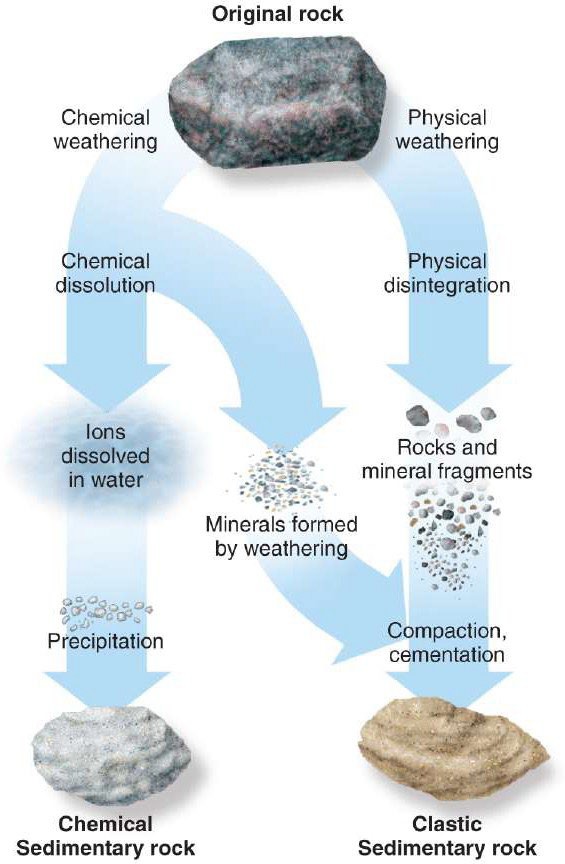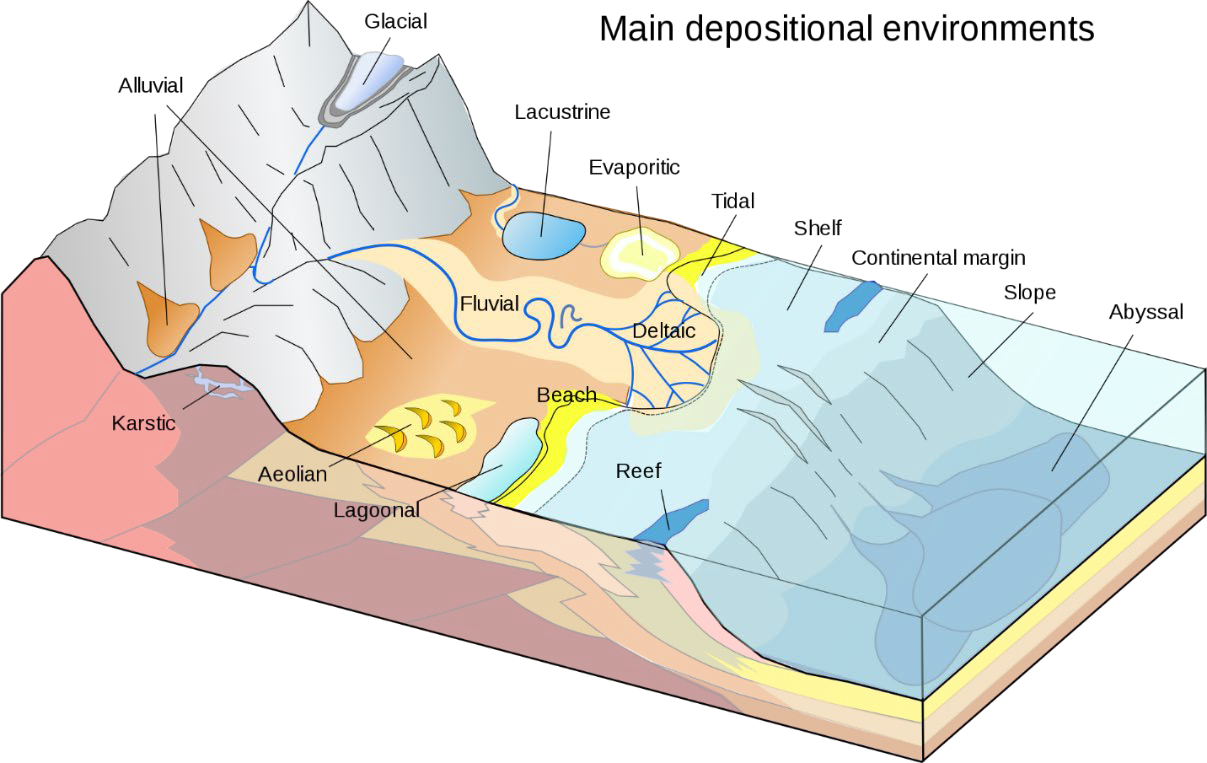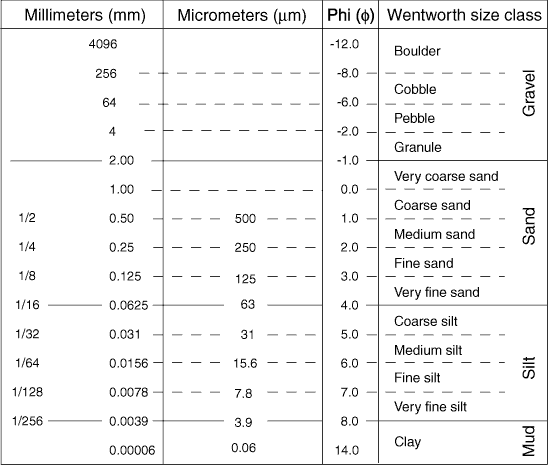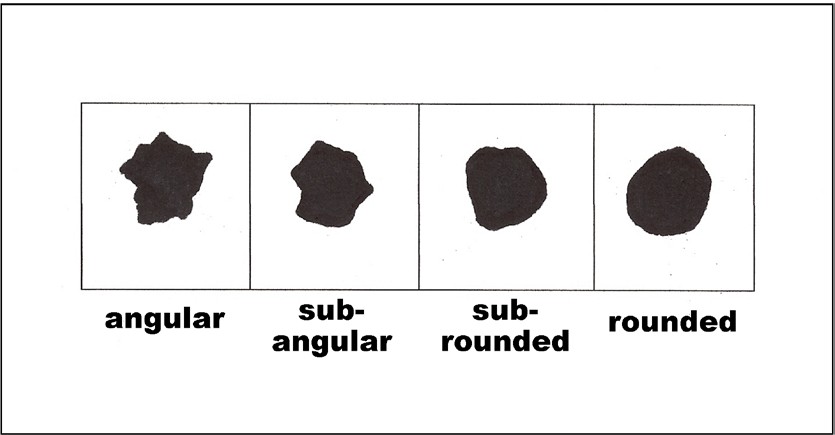6 Lab 6—Erosion, sedimentation, and sedimentary rocks

Figure 6.1. Close-up view of the sedimentary rock portion of the rock cycle.
Sedimentary rocks rock from the deposition, burial, cementation, and compaction or precipitation of sediments (Fig. 6.1). Referring back to the rock cycle as illustrated in Figure 3.1, these sediments may originate from any of the three types of rocks—igneous, sedimentary, or metamorphic. When the rocks are exposed at or near Earth’s surface, they experience weathering.
Weathering takes place when Earth surface materials such as rock, soil, and minerals are broken down, chemically or mechanically, into smaller pieces. Some examples of chemical weathering include dissolution, hydrolysis, and oxidation. Examples of mechanical weathering include frost wedging, root wedging, salt wedging, thermal expansion and contraction, exfoliation, and abrasion.
The products of weathering are removed from their source rock in a process called erosion and are then transported to their sink. This is the place where they are deposited. Sedimentary rocks are influenced by the composition of their source rock, the amount of erosion they undergo, and their depositional environment. For a schematic landscape diagram illustrating a variety of depositional environments, see Figure 6.2.
When sediments are buried and compacted, they lithify (or become rocks, from the Greek root word litho, meaning stone or rock). The processes of burial, compaction, and cementation that lead to lithification are collectively known as diagenesis. Diagenesis can occur deep below Earth’s surface and at high temperatures, but not so deep and hot as to cause metamorphosis.
Sedimentary rocks are classified into three main categories: siliciclastic, chemical, and biogenic (Table 6.1). Siliciclastic sedimentary rocks are formed from the fragments of mechanical erosion of other rocks. Siliciclastic rocks are then further classified according to the sizes of the grains that comprise the rock, and how rounded those grains are. Chemical rocks are initially classified by their chemical composition—carbonates are composed of calcite or dolomite; rock gypsum is made of gypsum; and rock salt is made
of halite. Carbonates are further divided according to grain size and presence or lack of visible fossils or ooids. The final category, biogenic sedimentary rocks, is formed as a result of the accumulation of organic matter. The two rocks we are concerned with in this category are bituminous coal and biogenic chert.

Figure 6.2. Sedimentary depositional environments (Mikenorton, 2018).
Clastic rocks: how do we measure the grain size of the sediments? Chester K. Wentworth devised a classification scheme to name the grains of sediments based on the size range of the diameters of the grains (Table 6.1). Grains are further described by how much they have been eroded. Those grains that were recently removed from their source rock and have not been transported are angular. They then receive labels of sub-angular, sub-rounded, or rounded, with increasing erosion and transport distance (Fig. 6.3).
Table 6.1. Wentworth (1922) grain-size classification.


Figure 6.3. Illustration of terms describing clastic grain rounding.
Table 6.2. Sedimentary rock identification table
|
Type |
Composition |
Rock Name |
|
|
SILICICLASTIC Formed from broken pieces of weathered rock (clasts). |
rounded cobbles and pebbles (clasts larger than 2 mm), sand, silt, and clay- sized grains |
Conglomerate |
|
|
angular cobbles, pebbles (clasts larger than 2 mm), sand, silt, and clay |
Breccia |
||
|
sand-sized grains (clasts between 2 mm and 1/16 mm) |
Grains almost all quartz |
Quartz sandstone |
|
|
Significant amounts of K-feldspar grains |
Arkose |
||
|
silt-sized grains (0.004 mm to 1/16 mm) |
Siltstone |
||
|
mixed silt and clay, smooth, hard, breaks into thin chips |
Shale |
||
|
clay-sized grains (smaller than 0.004 mm), smooth, clayey texture |
Claystone |
||
|
|
|
Calcite |
Limestone |
|
|
|
Dolomite |
Dolomite/Dolostone |
|
|
|
Calcite mud, microcrystalline limestone |
Micrite |
|
CHEMICAL Crystals within rock formed by inorganic precipitation. |
CARBONATE Composed of carbonate minerals such as calcite and dolomite. |
Calcite that has precipitated out of groundwater—banded |
Travertine |
|
Calcite, contains visible shell and skeletal fragments |
Fossiliferous limestone |
||
|
Calcite, almost entirely shell and skeletal fragments |
Coquina |
||
|
|
|
Calcite, composed of ooids |
Oolitic limestone |
|
|
|
Calcite, micro-skeletal fragments |
Chalk |
|
|
EVAPORITE |
Gypsum |
Rock gypsum |
|
|
Halite |
Rock salt |
|
|
BIOGENIC Forms as the result of an accumulation |
densely compacted organic material and plant fragments, typically black in color |
Bituminous coal |
|
|
silica (quartz), composed of |
Chert |
||
|
of organic material |
microorganisms called diatoms |
||
Lab Exercise: Sedimentary Rock Identification
|
Sample Number |
Sedimentary Rock Type |
Textural and Other Distinctive Properties —Grain Size/Grain Type |
Rock Name |
Depositional Environment: High or Low Energy? How did the rock form? |
|
1 |
|
|
|
|
|
2 |
|
|
|
|
|
3 |
|
|
|
|
|
4 |
|
|
|
|
|
5 |
|
|
|
|
|
6 |
|
|
|
|
|
7 |
|
|
|
|
|
8 |
|
|
|
|
|
9 |
|
|
|
|
|
10 |
|
|
|
|
|
11 |
|
|
|
|
|
12 |
|
|
|
|
|
13 |
|
|
|
|
|
14 |
|
|
|
|
|
15 |
|
|
|
|
|
16 |
|
|
|
|
REFERENCES
Ralph L. Dawes, Ph.D. and Cheryl D. Dawes, 2013, “Basics—Sedimentary Rocks,” in Geology 101—Introduction to Physical Geology, https://commons.wvc.edu/rdawes/g101ocl/basics/sedimentary.html; last access: 2022-07-07.
Mikenorton, 2018, “SedimentaryEnvironment.jpg,” derived from: “Principales medios sedimentarios.svg”, CC BY-SA 3.0, https://commons.wikimedia.org/w/index.php?curid=68836539; last access: 2022-07- 06.
Wentworth, Chester K. “A Scale of Grade and Class Terms for Clastic Sediments.” The Journal of Geology 30, no. 5 (1922): 377–92.
